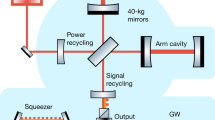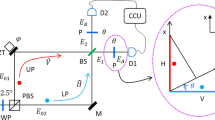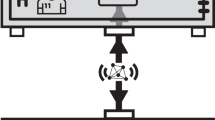Abstract
Fluctuations in the counting rate of photons originating from uncorrelated point sources become, within the coherently illuminated area, slightly enhanced compared to a random sequence of classical particles. This phenomenon, known in astronomy as the Hanbury Brown–Twiss effect1,2,3,4,5, is a consequence of quantum interference between two indistinguishable photons and Bose–Einstein statistics6. The latter require that the composite bosonic wavefunction is a symmetric superposition of the two possible paths. For fermions, the corresponding two-particle wavefunction is antisymmetric: this excludes overlapping wave trains, which are forbidden by the Pauli exclusion principle. Here we use an electron field emitter to coherently illuminate two detectors, and find anticorrelations in the arrival times of the free electrons. The particle beam has low degeneracy (about 10-4 electrons per cell in phase space); as such, our experiment represents the fermionic twin of the Hanbury Brown–Twiss effect for photons.
This is a preview of subscription content, access via your institution
Access options
Subscribe to this journal
Receive 51 print issues and online access
$199.00 per year
only $3.90 per issue
Buy this article
- Purchase on Springer Link
- Instant access to full article PDF
Prices may be subject to local taxes which are calculated during checkout



Similar content being viewed by others
References
Hanbury Brown, R. & Twiss, R. Q. A new type of interferometer for use in radio astronomy. Phil. Mag. 45, 663–682 (1954)
Hanbury Brown, R. & Twiss, R. Q. Correlation between photons in two coherent beams of light. Nature 177, 27–29 (1956)
Hanbury Brown, R. & Twiss, R. Q. The question of correlation between photons in coherent light rays. Nature 178, 1447–1448 (1956)
Hanbury Brown, R. & Twiss, R. Q. Interferometry of the intensity fluctuation in light I. Proc. R. Soc. Lond. 242, 300–324 (1957)
Hanbury Brown, R. & Twiss, R. Q. Interferometry of the intensity fluctuation in light II. An experimental test of the theory for partially coherent light. Proc. R. Soc. Lond. 243, 291–319 (1958)
Purcell, E. M. The question of correlation between photons in coherent light rays. Nature 178, 1449–1450 (1956)
Brannen, E. & Ferguson, H. I. S. The question of correlation between photons in coherent light beams. Nature 178, 481–482 (1956)
Hanbury Brown, R. The Intensity Interferometer 7 (Taylor and Francis, New York, 1974)
Hanbury Brown, R. & Twiss, R. Q. A test of a new type of stellar interferometer on Sirius. Nature 178, 1046–1448 (1956)
Silverman, M. P. On the feasibility of observing electron antibunching in a field-emission beam. Phys. Lett. A 120, 442–446 (1987)
Kodama, T. et al. Feasibility of observing two-electron interference. Phys. Rev. A 57, 2781–2785 (1998)
Henny, M. et al. The fermionic Hanbury Brown and Twiss experiment. Science 284, 296–298 (1999)
Oliver, W. D., Kim, J., Liu, R. C. & Yamamoto, Y. Hanbury Brown and Twiss-type experiment with electrons. Science 284, 299–301 (1999)
Twiss, R. Q. & Little, A. G. The detection of time-correlated photons by a coincidence counter. Aust. J. Phys. 12, 77–93 (1959)
Hasselbach, F. A ruggedized miniature UHV electron biprism interferometer for new fundamental experiments and applications. Z. Phys. B 71, 443–449 (1988)
Goldberger, M. L., Lewis, H. W. & Watson, K. M. Use of intensity correlations to determine the phase of a scattering amplitude. Phys. Rev. 132, 2764–2787 (1963)
Silverman, M. P. New quantum effects of confined magnetic flux on electrons. Phys. Lett. A 118, 155–158 (1986)
Silverman, M. P. in OSA Proceedings on Photon Correlation Techniques and Applications (eds Abbiss, J. B. & Smart, E. A.) Vol. 1 26–34 (OSA, Washington DC, 1988)
Silverman, M. P. Distinctive quantum features of electron intensity correlation interferometry. Il Nuovo Cimento 97, 200–219 (1987)
Acknowledgements
We thank M. Silverman, M. Lenc, T. Tyc, A. Oed and P. Sonnentag for discussions, and the Deutsche Forschungsgemeinschaft for financial support.
Author information
Authors and Affiliations
Corresponding author
Ethics declarations
Competing interests
The authors declare that they have no competing financial interests.
Rights and permissions
About this article
Cite this article
Kiesel, H., Renz, A. & Hasselbach, F. Observation of Hanbury Brown–Twiss anticorrelations for free electrons. Nature 418, 392–394 (2002). https://doi.org/10.1038/nature00911
Received:
Accepted:
Issue Date:
DOI: https://doi.org/10.1038/nature00911
This article is cited by
-
Multiphoton electron emission with non-classical light
Nature Physics (2024)
-
Few-electron correlations after ultrafast photoemission from nanometric needle tips
Nature Physics (2023)
-
Coulomb-correlated electron number states in a transmission electron microscope beam
Nature Physics (2023)
-
Ultrasound-induced biophysical effects in controlled drug delivery
Science China Life Sciences (2022)
-
Observation of the modification of quantum statistics of plasmonic systems
Nature Communications (2021)
Comments
By submitting a comment you agree to abide by our Terms and Community Guidelines. If you find something abusive or that does not comply with our terms or guidelines please flag it as inappropriate.



